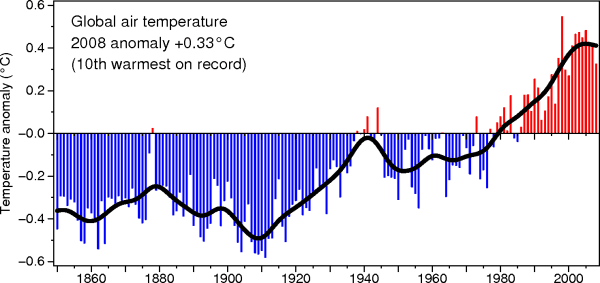Scientists look at the big picture, not today’s weather, to see the impact of climate change
February 25, 2009; Scientific American; Earth Talk
Don’t all these huge snow and ice storms across the country mean that the globe isn’t really warming? I’ve never seen such a winter!
— Mark Franklin, Helena, MT

“Warmer temperatures in the winter of 2006 caused Lake Erie to not freeze for the first time in its history. This actually led to increased snowfalls because more evaporating water from the lake was available for precipitation.”
“This rise has not been smooth and steady, nor would it be expected to be. Nothing about weather is smooth and steady, but the trend is clear and extreme.”
On the surface it certainly can appear that way. But just because some of us are suffering through a particularly cold and snowy winter doesn’t refute the fact that the globe is warming as we continue to pump carbon dioxide and other greenhouse gases into the atmosphere.
According to the National Aeronautics and Space Administration (NASA), in 2009, the 10 warmest years on record have occurred since 1997. And the National Atmospheric and Oceanographic Administration (NOAA) reports that recent decades have been the warmest since at least around 1000 AD, and that the warming we’ve seen since the late 19th century is unprecedented over the last 1,000 years.
“You can’t tell much about the climate or where it’s headed by focusing on a particularly frigid day, or season, or year, even,” writes Eoin O’Carroll of the Christian Science Monitor. “It’s all in the long-term trends,” concurs Dr. Gavin Schmidt, a climatologist at NASA’s Goddard Institute for Space Studies.
Most scientists agree that we need to differentiate between weather and climate. The NOAA defines climate as the average of weather over at least a 30-year period. So periodic aberrations-like the harsh winter storms ravaging the Southeast and other parts of the country this winter-do not call the science of human-induced global warming into question.
But while more extreme weather events of all kinds-from snowstorms to hurricanes to droughts-are likely side effects of a climate in transition, most scientists maintain that any year-to-year variation in weather cannot be linked directly to either a warming or cooling climate.
Even most global warming skeptics agree that a specific cold snap or freak storm doesn’t have any bearing on whether or not the climate problem is real. One such skeptic, Jimmy Hogan of the Rational Environmentalist website writes, “If we are throwing out anecdotal evidence that refutes global warming we must at the same time throw out anecdotal evidence that supports it.” He cites environmental groups holding up Hurricane Katrina as proof of global warming as one example of the latter.
If nothing else, we should all keep in mind that every time we turn up the thermostat this winter to combat the cold, we are contributing to global warming by consuming more fossil fuel power. Until we can shift our economy over to greener energy sources, global warming will be a problem, regardless of how warm or cold it is outside.
CONTACTS: NASA, www.nasa.gov; NOAA, www.noaa.gov.
Global Warming Bringing More Oddball Winter Weather
Peculiar winter weather includes more heavy snowfalls, disruptions to local economies – map of recent oddball weather events reflects trends of what’s expected in years ahead
01-28-2010 // Aileo Weinmann
“The mountain snow sports that depend on reliable snow conditions provide about $66 billion to our economy — and the local economies that rely on those dollars are becoming increasingly vulnerable. The extreme efforts necessary to provide snow for the Vancouver Olympics are a startling example of what’s at stake.”
From coast to coast, the report details recent oddball winter weather events in regions that are expected to see more of the same if global warming pollution continues unabated.
“We need to take these trends toward more oddball winter weather events into account when planning for snow removal, flood management, and recreation and tourism,” said Dr. Staudt. “We can no longer plan based on the climate we used to have.”
Milder winters disrupt ecosystems in some surprising ways.
Bitter cold temperatures naturally limit the spread of pests, diseases, and invasive species. The absence of extreme winter cold across the mountainous West has enabled an explosion of mountain pine beetles and caused a massive die-off of pine forests. Some important plants-–for example, walnuts, peaches, and cherries — require a certain exposure to cold in order to flourish. Plants and animals also can be caught unawares when milder conditions are punctuated by severe winter weather. Across the Great Plains and Southeast United States, a cold snap in early April 2007 caused more than $2 billion in crop losses after an unusually warm March led to premature crop growth.
in January 06, 2008 Iran was hit by the heaviest snowfall they have ever experienced. Several people died because of the extreme cold. There were those who found themselves trapped in their cars and the homeless had no choice but to bear the cold in the streets. What’s more startling is that some desert areas even received snowfall for the first time in history.
In other parts of the globe, Buenos Aires was unprepared for snow since the last recorded snowfall in this country was 89 years ago. Nearby, the people of Peru suffered from an intense cold spell where hundreds of people died; prompting the government to declare 14 of their provinces under a “state of emergency.” Its neighbor Chile, through its agriculture minister, sadly reported losses of at least $200 million in destroyed crops and livestock brought by the toughest winter this country ever experienced in the past 50 years.





